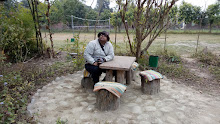Tridax procumbens (L.) L
COAT BUTTON !!
COMMON NAME : Tridax Daisy, Coat Buttons, Mexican Daisy
BOTANICAL NAME :Tridax procumbens (L.) L.
FAMILY : Asteraceae (Sunflower family)
HABITAT AND HABIT : This pretty daisy-like flower is very common all over the plains of northern India. It is best known as a widespread weed and pest plant. It is native to the tropical Americas but it has been introduced to tropical, subtropical, and mild temperate regions worldwide. It is listed as a noxious weed in the United States and has pest status in nine states.
DESCRIPTION : Tridax daisy stands about 30-60 cm high
STEM : It has slightly hairy stems.
LEAF : The leaves are ovate or lanceolate with toothed edges.
FLOWER : The small creamy or white flower has five petals which are notched on the outer edges. The centre of the flower is yellow. This plant has flowers all the year around, but from May to December is the time that it is fully in bloom. It is found along paths, roadsides and in the crevices of walls and rocks. It is a great favourite with low flying butterflies. In the areas where there is a great concentration of these flowers one will find plenty of butterflies too.
FRUIT : Its fruit is a hard achene covered with stiff hairs and having a feathery, plumelike white pappus at one end.
CHEMICAL CONSTITUENTS : A new flavonoid (procumbenetin), isolated from the aerial parts of Tridax procumbens, has been characterised as 3,6-dimethoxy-5,7,2',3',4'-pentahydroxyflavone 7-O-β-D-gluco- pyranoside on the basis of spectroscopic techniques and by chemical means.Tridax procumbens; Flavonoids Plant. Uses in traditional medicine. Commonly used in Indian traditional medicine as anticoagulant, hair tonic, antifungal and insect repellent, in bronchial catarrh, diarrhoea, dysentery, and wound healing. Previously isolated constituents. Alkyl esters, sterols, pentacyclic triterpenes , fatty acids and polysaccharides . New isolated constituent. 3,6-Dimethoxy-5,7,2',3',4'-pentahydroxyflavone 7-O-β- D-glucopyranoside , named procumbetin Žyield: 0.016% on dried basis..
USES : The leaves are cooked and eaten as a vegetable. Medicinally, they are used to treat bronchial catarrh, dysentery and diarrhoea. Uses in traditional medicine. Commonly used in Indian traditional medicine as anticoagulant, hair tonic, antifungal and insect repellent, in bronchial catarrh, diarrhoea, dysentery, and wound healing.
ECOLOGY : It is found along paths, roadsides and in the crevices of walls and rocks. It is a great favourite with low flying butterflies. In the areas where there is a great concentration of these flowers one will find plenty of butterflies too. Flowers attractive to butterflies and bees.
SOURCES :
>>http://www.flowersofindia.net/catalog/slides/Tridax%20Daisy.html
>>http://en.wikipedia.org/wiki/Tridax_procumbens
>>http://rmbr.nus.edu.sg/dna/organisms/details/559
>>http://opendata.keystone-foundation.org/tridax-procumbens-l
.JPG)
%5D+ban+tulsi.JPG)










0 comments:
Post a Comment